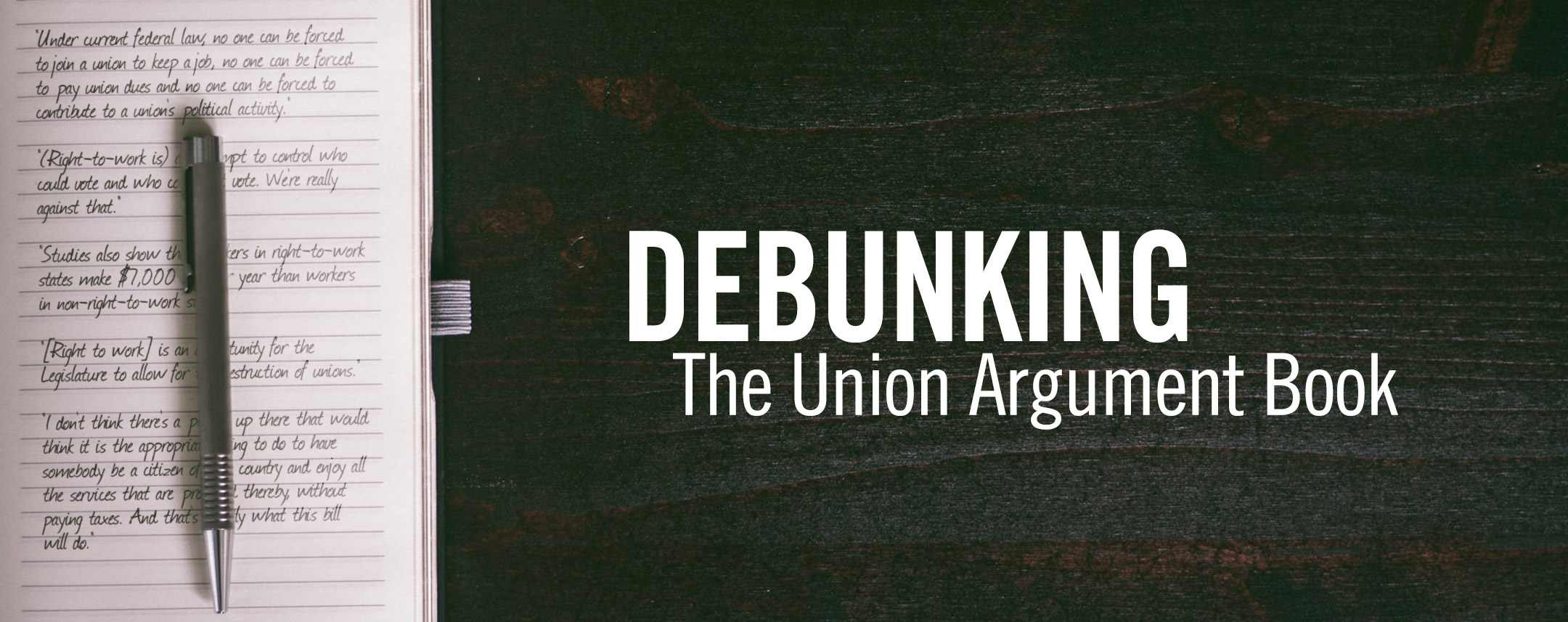While legislation to extend right-to-work protections to Washington employees has been periodically introduced in the state legislature in recent years, the 2017 legislative session marked the first time, at least in recent history, in which such legislation has received a committee hearing.
On Feb. 8, the Senate Commerce, Labor and Sports Committee conducted a hearing on SB 5692, introduced by Sen. Michael Baumgartner (R-Spokane).
The legislation sought to prevent employees in both the public and private sectors from being fired for refusing to pay dues or fees to a labor union. Current state law permits union-represented employees to be required to pay union dues and/or fees as a condition of employment.
So far, 27 states have adopted right-to-work laws, including both Kentucky and Missouri in 2017.
Despite their popularity — seven in 10 Americans support right-to-work protections — union officials in forced-unionism states like Washington, Oregon and California detest right-to-work laws and would prefer to keep forcing employees to pay dues whether they want to or not.
At the hearing, union lobbyists lined up to speak against the bill, raising nearly every argument in the book against right-to-work (over 1,000 union workers, primarily in construction and trade unions, also turned out in opposition).
Here are the top 10 noteworthy, inaccurate or just plain mystifying things said about right-to-work during the hearing:
- “Under current federal law, no one can be forced to join a union to keep a job, no one can be forced to pay union dues and no one can be forced to contribute to a union’s political activity.”
–
Jeff Johnson, president of the Washington State Labor Council.
Johnson’s comment is technically accurate, but very misleading. It is true that no one can be “forced to join a union” as a member in good standing. In other words, a person can’t be required to sign a union membership card, attend union meetings or subject themselves to the union’s bylaws.
What Johnson doesn’t say, however, is that employees can still be required, as a condition of employment, to accept union representation and to pay union “fees.” Under state law, public employees who choose not to formally join a union must automatically pay a fee “equal to the amount required to become a member in good standing.” Thus, the next part of Johnson’s statement, that “no one can be forced to pay union dues,” is also technically accurate because only “members” pay “dues” while nonmembers pay “fees” equal to dues.
Lastly, Johnson claims “no one can be forced to contribute to a union’s political activity.” Again, while true in a technical sense, current law in practice often results in public employees funding political activity through their union dues that they wouldn’t otherwise choose to support.
As a result of the U.S. Supreme Court’s decisions in Abood v. Detroit Board of Education (1977), Chicago Teachers Union v. Hudson (1986) and Communications Workers of America v. Beck (1988), unions have to periodically calculate (1) the percentage of their budgets spent on “chargeable” activity that relates to negotiating and administering union contracts, and (2) the percentage they spend on “nonchargeable” activity like political contributions. All union-represented employees have the option of paying a reduced “agency fee” to the union to cover their pro rata share of the union’s chargeable expenses instead of full dues.
However, there are at least eight reasons why the current system inadequately protects public employees from being forced to support union political activity against their will:
- Under Washington law, union-represented workers pay an amount equal to full membership dues by default. Employees must affirmatively opt out of supporting union politics instead of opting in.
- Many union-represented workers are unaware they may opt out of paying for union political activity. Union officials have a financial incentive to keep members from learning of their rights.
- Workers are often required to annually renew their objection to paying for anything other than workplace representation.
- Unions frequently only permit workers to opt out or renew their objection during a limited annual window as short as 10 days.
- Unions sometimes retaliate against employees seeking to resign union membership or will simply refuse to process their requests.
- Unions get to calculate the chargeable fee. While employees can challenge the union’s calculation, the burden is on the employee to disprove the validity of the union’s fee, a difficult task given the scant information available to many public employees about their union’s financial practices.
- Because workers must resign their union membership in order to pay the reduced representation fee, they must also give up their ability to participate in any union governance, including the ability to vote on their employment contract, even though they must still pay for the cost to the union of negotiating and administering the contract.
- Even paying only for workplace representation alone can still force workers to support political speech or a viewpoint they do not share, as 10 Washington teachers explained in a 2016 Seattle Times op-ed
- “(Right-to-work is) an attempt to control who could vote and who could not vote. We’re really against that.”
–
Lee Newgent, executive secretary of the Washington State Building and Construction Trades Council.
Well, if that’s what right-to-work laws did, the Freedom Foundation would oppose them, too. But thankfully, right-to-work laws do not prevent unions from existing, forming or bargaining as they do now, much less restrict anyone’s ability to vote. The only thing a right-to-work law does is establish that employees cannot lose their job for refusing to pay dues or fees to a labor union. That’s it.
- “Studies also show that workers in right-to-work states make $7,000 less per year than workers in non-right-to-work states.”
–
John Holden, president of the International Association of Machinists Lodge 751.
It’s not clear precisely how Holden arrived at the $7,000 number, but the claim that right-to-work laws lower wages is pretty common.
The Congressional Research Service summarized the research on the subject in 2014 thusly:
“Wages are lower in RTW states than union security states. Historical research has suggested that RTW laws have little influence on these differences. More contemporary scholarship has come to diverse conclusions, depending on the researchers’ methodology.”
Nevertheless, unions continue to make dire predictions about the loss in wages they believe will occur under right-to-work.
The AFL-CIO claimed earlier this year:
“On average, workers in states with right to work laws make $6,109 a year (12.1%) less annually than workers in other states ($44,401, compared with $50,511). Median household income in states with these laws is $8,174 (13.9%) less than in other states ($50,712 vs. $58,886).
But simply comparing average wages among states doesn’t take into account regional differences in the cost of living. Though spreading to other parts of the country, most right-to-work states are concentrated in the southeast, a region with a lower-than-average cost of living. States with a lower cost of living tend to also have lower wages, but that doesn’t mean the people living there are any worse off materially. Even most labor academics recognize, at least in theory, that comparisons between right-to-work and non-right-to-work states need to account for cost of living and other variables.
The most sophisticated left-of-center study on the subject, conducted in 2015 by researchers at the Economic Policy Institute, claimed to find that,
“Wages in RTW states are 3.1 percent lower than those in non-RTW states, after controlling for a full complement of individual demographic and socioeconomic factors as well as state macroeconomic indicators. This translates into RTW being associated with $1,558 lower annual wages for a typical full-time, full-year worker.”
When experts at the right-leaning Heritage Foundation replicated the EPI study, however, they discovered that EPI’s model “only accounts for three-quarters of the difference in living costs between states.” The Heritage paper concluded that, “Completely controlling for price differences eliminates the negative effects of right-to-work on wages that EPI reported.”
- “[Right to work] is an opportunity for the Legislature to allow for the destruction of unions.”
–
Tim Burns, Puget Sound Advocates for Retirement Action
Because the federal National Labor Relations Act establishes and regulates private-sector collective bargaining, the state Legislature could not “destroy” private-sector unions even if it wanted to. Collective bargaining for non-federal public employees is governed entirely by state law, however. The Legislature has periodically extended collective bargaining rights to new classifications of public employees since the 1960s. To the best of our knowledge, the Legislature has never repealed collective bargaining rights for any public employees, though the Legislature would certainly have the authority to do so if it saw fit. But literally no one is proposing this. All SB 5692 would do, and all any right-to-work bill does, is allow union-represented employees to make their own choices about union membership.
- “I don’t think there’s a person up there that would think it is the appropriate thing to do to have somebody be a citizen of this country and enjoy all the services that are provided thereby, without paying taxes. And that’s exactly what this bill will do.”
–
Tim Carter, Sheet Metal Workers Local 66
This is a variation of the “free-rider” argument frequently raised by labor against right-to-work. Understanding it requires a little bit of Labor Law 101.
First, unions in the private-sector are governed by the federal National Labor Relations Act (NLRA). If a union is certified by the National Labor Relations Board as the “exclusive bargaining representative” of a particular “bargaining unit” of employees, then it essentially becomes the indefinite monopoly provider of workplace representation services for those workers. The union contract applies to all the employees, who may not represent themselves or accept representation from another source. For its part, the union must represent all employees in the bargaining unit, whether they choose to become members of the union or not.
In non-right-to-work states, employees who choose not to be union members can still be required to pay a representation fee to the union, which is typically equivalent to full dues. Union-represented employees in right-to-work states, however, cannot be required to pay any dues or fees to the union if they don’t want to.
Thus, unions claim that right-to-work laws force them to provide services to “free riders” who do not wish to pay dues.
But the NLRA does not require unions to become an “exclusive bargaining representative.” In fact, as James Sherk of the Heritage Foundation explains, the Supreme Court has long acknowledged that unions may choose instead to negotiate “members-only” contracts that apply only to those employees in the bargaining unit who choose to be members of the union. In Retail Clerks v. Lion Dry Goods, Inc., 369 U.S. 17 (1962), the court recognized that the types of contracts governed by the NLRA and subsequent Labor Management Relations Act are “not limited to collective bargaining agreements concerning hours, wages and conditions of employment concluded in direct negotiations between employers and unions entitled to recognition as exclusive bargaining representatives of employees.” (Emphasis added.) The decision notes further that “‘members- only’ contracts have long been recognized.”
Admittedly, such contracts are currently quite rare. Even in right-to-work states, unions generally prefer to be the monopoly “exclusive bargaining representative,” with the accompanying obligation to represent nonmembers, rather than bargain only on behalf of union members, which would allow nonunion employees to negotiate their terms and conditions of employment directly with their employer.
However, “members-only” contracts used to be quite common. In his book, The Blue Eagle at Work (2005), labor scholar Charles Morris, professor emeritus at Southern Methodist University’s Dedman School of Law, observes:
“Historically, including the years immediately preceding passage of the Wagener Act, collective bargaining as an institution was intertwined with the concept of union membership… Unions thus normally bargained only on behalf of their members… When a union was not strong enough to obtain a closed shop or even full recognition, it often settled for a members-only collective agreement…” (pages 20-21).
In the preface to the book, Theodore J. St. Antoin, professor emeritus and former Dean of the University of Michigan School of Law, notes:
“…members-only contracts were common sights in the labor relations landscape at the time the NIRA and the NLRA were adopted.” (page xii)
Under SB 5692, unions representing private-sector employees would not be able to require employees to pay dues as a condition of employment, but nothing would prevent unions from bargaining only on behalf of their members as already permitted by federal law.
Second, unions representing non-federal public employees are governed by Washington state’s collective bargaining laws. State law does require that unions represent all employees in a bargaining unit regardless of their union membership status. SB 5692 would not change this requirement.
In his comments, Carter compared allowing union-represented employees to avoid paying dues to allowing citizens to avoid paying taxes, an analogy often employed by right-to-work opponents. The problem is, government is an exceptional institution. Government has been delegated authority to carry out a set of defined duties deemed necessary to facilitate a functioning society and economy. Unions, by contract, are private organizations in the business of providing workplace representation services and collecting dues. It is quite rare for private-organizations to have the extraordinary legal authority to “tax” (require dues payment from) individuals.
In a free society, the use of force to compel association with or payments to private organizations should be minimized. There are plenty of flourishing voluntary associations that provide valuable services benefitting people who are not members. Should every gun owner in the country be required to join the National Rifle Association? Should every business owner be required to pay dues to a trade association? Despite having voluntary membership, these organizations exist and thrive by proving their value and convincing people to support them.
While public employees who refuse to pay dues are derided as “free riders,” a more accurate description would be “forced riders.” Many of these employees do not wish to receive the union’s representation in the first place and resent being required to pay for a mandatory service they do not feel is in their best interest.
- “Infant mortality in right to work states is 12.4 percent higher than in non-right-to-work states.”
–
Sen. Karen Keiser (D-Kent)
This is a talking point straight from the AFL-CIO. The AFL-CIO cites the Henry J. Kaiser Family Foundation, which published information from the Center for Disease Control (CDC) about the infant mortality rate by state in 2013. However, neither the Kaiser Family Foundation nor the CDC make any statements about the effect of right-to-work on infant mortality. Rather, the AFL-CIO appears to have used the data to calculate on its own the average infant mortality rate in right-to-work states in 2013 and compared it to the average infant mortality rate in non-right-to-work states.
The problem is there are many factors that affect the infant mortality rate in a given state, and trying to connect giving people choices about union membership with babies dying is a bit of a stretch. In 2015, Politifact rated the claim that infant mortality is higher in right-to-work states “half true” because, while correct, there is no evidence showing that right-to-work laws actually cause elevated infant mortality.
- “Households in states that have this right to work law have… about a five percent higher poverty rate.”
– Sen. Karen Keiser (D-Kent)
This argument appears to come from the AFL-CIO, which claimed earlier this year:
“Poverty rates are higher in states with right to work laws (15.3% overall and 21.4% for children), compared with poverty rates of 12.8% overall and 18.0% for children in states without these laws.”
As with infant mortality, however, there are many factors that influence a state’s poverty rate beyond whether it has a right-to-work law, and research has not established any direct link between right-to-work laws and poverty.
Comparing states based on their poverty rates is particularly problematic because, as the Census Bureau explains, it
“…uses a set of money income thresholds that vary by family size and composition to determine who is in poverty. If a family’s total income is less than the family’s threshold, then that family and every individual in it is considered in poverty. The official poverty thresholds do not vary geographically…”
While the income levels used to determine the poverty thresholds “do not vary geographically,” the cost of living does. In other words, a person living in a lower-wage state with a lower cost of living could fall beneath the poverty threshold, while a person earning a higher wage in a state with a higher cost of living does not, even though the two individuals share the same material standard of living.
Because of the inherent flaws of the standard poverty measurement, the Census Bureau has, in recent years, begun issuing a “supplemental poverty measure” (SPM), which it describes as,
“…a more complex statistic incorporating additional items such as tax payments and work expenses in its family resource estimates. Thresholds used in the new measure will be derived from Consumer Expenditure Survey expenditure data on basic necessities (food, shelter, clothing and utilities) and will be adjusted for geographic differences in the cost of housing. Unlike the official poverty thresholds, the new thresholds are not intended to assess eligibility for government programs. Instead, the new measure will serve as an additional indicator of economic well-being and will provide a deeper understanding of economic conditions and policy effects.”
Using the more accurate SPM virtually erases the difference in poverty rates between right-to-work and non-right-to-work states. Data from the Census Bureau’s 2015 SPM indicate that the average poverty rate in right-to-work states was 13.6 percent, compared to 13.4 percent for non-right-to-work states.
- “As we’ve seen across our country, you can carve us out but at some point you will come and get us just as much with a knife.”
–
Dennis Lawson, president of the Washington State Council of Firefighters.
Context is only partially helpful here. As drafted, SB 5692 “carves out” and would not apply to unions representing police, firefighters or other emergency and law enforcement personnel. In other words, Lawson’s union could still force firefighters to pay union dues whether they want to or not.
Apparently, the reason for Lawson’s macabre knife reference is his suspicion that, if the Legislature passed SB 5692 — not likely in the state’s current political climate — it would eventually revisit the issue and extend right-to-work protections to firefighters and policeman, too, as has purportedly happened “across the country.”
It is true that state-level labor reforms in recent years in states like Wisconsin and Michigan have exempted police and firefighters. So far, though, none of those states has gone back and extended right-to-work protections to first responders, though there’s an argument to be made they never should have been exempted in the first place. Could these states eventually decide to give first responders right-to-work protections along with other public employees? Of course.
For now, though, Lawson’s statement that the Legislature was going to “come and get” first responders “with a knife” is, to put it mildly, pretty hyperbolic.
- “The intent of this bill and of bills like it in other states is to bankrupt unions.”
–
Jan Busser, Washington State Nurses Association
Right-to-work laws have been around since the late 1940s, yet unions in these states continue to exist. The teachers’ union in Alabama, for example, has been described as “one of the best-organized and funded state unions in the nation,” despite the state’s right-to-work law.
Contrary to the doomsday predictions, at least some labor officials in right-to-work states actually believe right-to-work laws can aid union organizing. Consider these comments made to the Washington Post in 2014 by Gary Casteel, the southern region director for the United Auto Workers:
“This is something I’ve never understood, that people think right to work hurts unions. To me, it helps them. You don’t have to belong if you don’t want to. So if I go to an organizing drive, I can tell these workers, ‘If you don’t like this arrangement, you don’t have to belong.’ Versus, ‘If we get 50 percent of you, then all of you have to belong, whether you like to or not.’ I don’t even like the way that sounds, because it’s a voluntary system, and if you don’t think the system’s earning its keep, then you don’t have to pay.”
This is precisely the message Kenny Riley, president of the International Longshoremen’s Association Local 1422 advised the International Association of Machinists employ in their drive to organize Boeing workers in South Carolina:
“The message IAM needs to send to workers who may be on the fringe is that, ‘to those of you who are skeptical about joining, you don’t have to join. Vote for the union and let the union come in and prove they can make life better for you. You can vote for the union and never join.'”
Lastly, commenting on the increase in union membership in Michigan that followed the state’s adoption of a right-to-work law, UAW president Dennis Williams observed, “I’ve always believed that if you do your job representing people, that people will be there to support you.”
Union membership numbers lend credence to the idea that right-to-work laws do not mean the end of unions. Using data from the Bureau of Labor Statistics, the Illinois Policy Institute calculated that, from 2005-2014, union membership in non-right-to-work states “collapsed by 9 percent, on average… Meanwhile, union membership has experienced a modest growth of 1.3 percent in Right-to-Work states, where workers have the freedom to join or opt out of unions altogether.”
Unions that do not prove their value to their members do have reason to worry about right-to-work, however. Since the U.S. Supreme Court extended right-to-work protections to Washington’s 7,000 state-paid family child care providers in 2014, many providers have determined it’s not worth being a member of SEIU 925. State payroll data indicate that, as of November 2016, only 38.7 percent of providers remained members of the union.
- “We currently have something in front of us (SB 5692) that will devastate the career skills programs at Joint Base Lewis-McChord and other bases because the bases require that we have a minimum wage rate between $17 and $20 to start to recruit service members as they come home.”
–
Christopher Winters, International Union of Painters and Allied Trades
If unions are an intrinsic good for society and the economy, as union officials believe, then anything that has to potential to work against a union’s perceived interests can be turned by its defenders into an attack on just about anything else that’s good and wholesome in the world. That appears to be what’s happening here.
While it’s open for interpretation, Winters’ appears to believe: Unions are good for the middle class and bolster everyone’s wages, right-to-work laws will weaken unions, weakening unions will erode their ability to raise everyone’s wages, wages will far so dramatically that trades unions will be unable to command wages high enough to allow them to participate in military career skills programs, and therefore military veterans won’t be able to find work.
This one definitely wins the “Slippery Slope” award.










